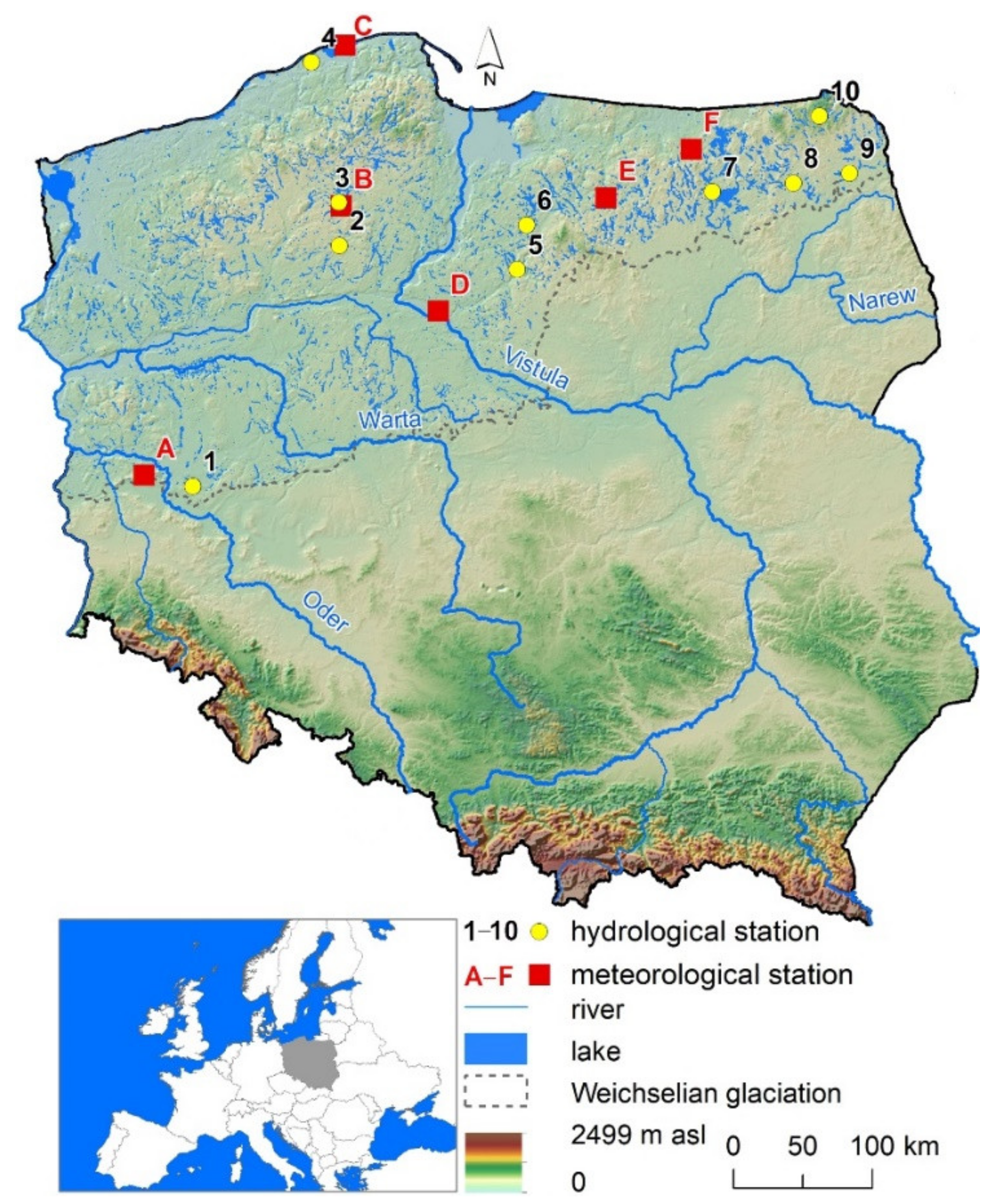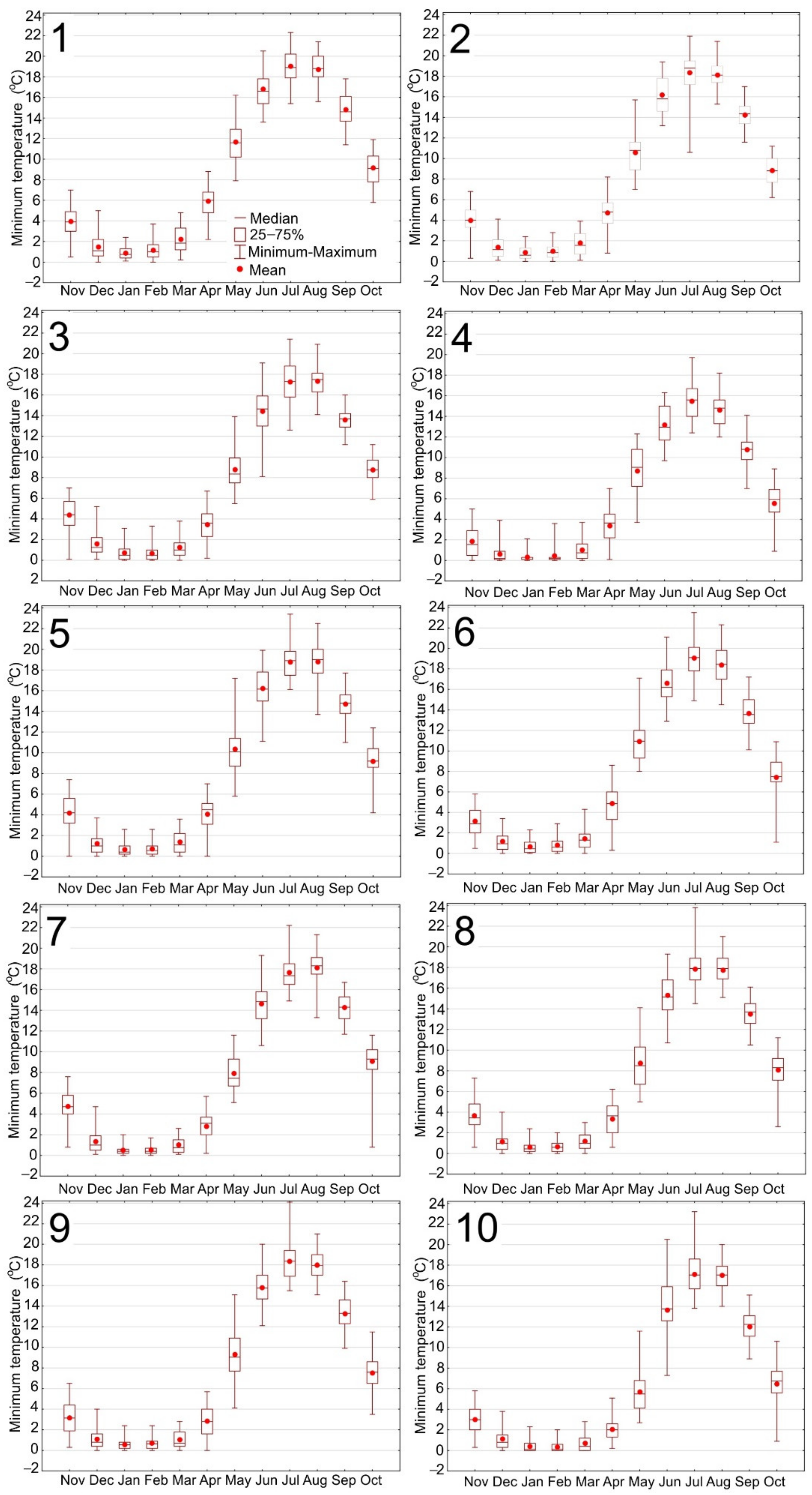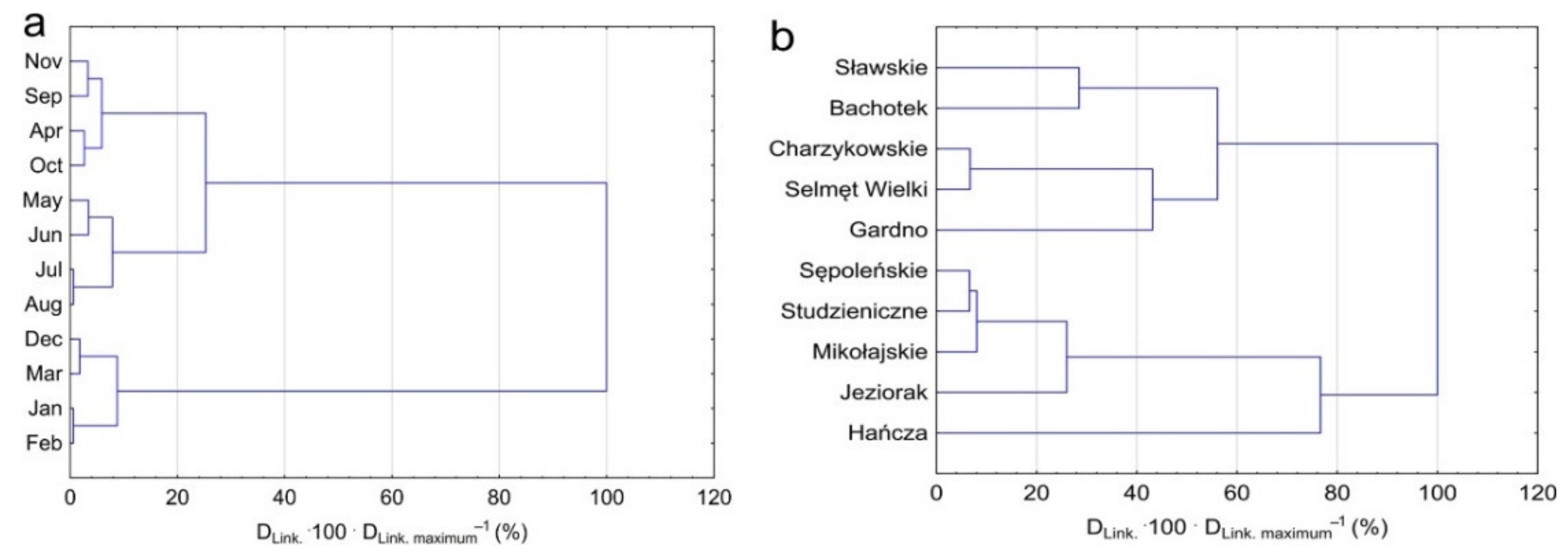Trends of Changes in Minimum Lake Water Temperature in Poland
Abstract
1. Introduction
2. Materials and Methods
2.1. Study Objects
2.2. Materials
2.3. Methods
2.4. Statistical Analysis
3. Results
4. Discussion
5. Conclusions
Supplementary Materials
Author Contributions
Funding
Institutional Review Board Statement
Informed Consent Statement
Data Availability Statement
Conflicts of Interest
References
- Ptak, M.; Choiński, A.; Strzelczak, A.; Targosz, A. Disappearance of Lake Jelenino since the end of the XVIII century as an effect of anthropogenic transformations of the natural environment. Pol. J. Environ. Stud. 2013, 22, 191–196. [Google Scholar]
- Choiński, A.; Ptak, M.; Strzelczak, A. Present-day evolution of coastal lakes based on the example of Jamno and Bukowo (the Southern Baltic coast). Oceanol. Hydrobiol. Stud. 2014, 43, 178–184. [Google Scholar] [CrossRef]
- Liu, Y.; Yang, S.-Q.; Jiang, C.; Sivakumar, M.; Enever, K.; Long, Y.; Deng, B.; Khalil, U.; Yin, L. Flood Mitigation Using an Innovative Flood Control Scheme in a Large Lake: Dongting Lake, China. Appl. Sci. 2019, 9, 2465. [Google Scholar] [CrossRef]
- Luo, Y.; Dong, Z.; Liu, Y.; Zhong, D.; Jiang, F.; Wang, X. Safety design for water-carrying Lake flood control based on copula function: A Case study of the Hongze Lake, China. J. Hydrol. 2021, 597, 126188. [Google Scholar] [CrossRef]
- Nowak, B.; Dumieński, G. Znaczenie jezior w gospodarce kraju. Gospod. Wodna 2020, 8, 8–14. [Google Scholar]
- Kirillin, G.B.; Shatwell, T.; Wen, L. Ice-Covered Lakes of Tibetan Plateau as Solar Heat Collectors. Geophys. Res. Lett. 2021, 48, e2021GL093429. [Google Scholar] [CrossRef]
- Flood, B.; Wells, M.; Midwood, J.D.; Brooks, J.; Kuai, Y.; Li, J. Intense variability of dissolved oxygen and temperature in the internal swash zone of Hamilton Harbour, Lake Ontario. Inland Waters 2021, 11, 162–179. [Google Scholar] [CrossRef]
- Hansen, G.J.A.; Read, J.S.; Hansen, J.F.; Winslow, L.A. Projected shifts in fish species dominance in Wisconsin lakes under climate change. Glob. Chang. Biol. 2017, 23, 1463–1476. [Google Scholar] [CrossRef]
- Stefanidis, K.; Varlas, G.; Papaioannou, G.; Papadopoulos, A.; Dimitriou, E. Trends of lake temperature, mixing depth and ice cover thickness of European lakes during the last four decade. Sci. Total Environ. 2022, 830, 154709. [Google Scholar] [CrossRef] [PubMed]
- Ptak, M. Long-term temperature fluctuations in rivers of the Fore-Sudetic region in Poland. Geografie 2018, 123, 279–294. [Google Scholar] [CrossRef]
- Zhu, S.; Ptak, M.; Choiński, A.; Wu, S. Exploring and quantifying the impact of climate change on surface water temperature of a high mountain lake in Central Europe. Environ. Monit. Assess. 2020, 192, 7. [Google Scholar] [CrossRef]
- Mushtaq, F.; Ahmed, P.; Nee Lala, M.G. Variability of lake surface water temperature: A case study during El Nino and La Nina events over the Himalayan lake region. Phys. Geogr. 2021, 42, 240–264. [Google Scholar] [CrossRef]
- Fukushima, T.; Matsushita, B.; Sugita, M. Quantitative assessment of decadal water temperature changes in Lake Kasumigaura, a shallow turbid lake, using a one-dimensional model. Sci. Total Environ. 2022, 845, 157247. [Google Scholar] [CrossRef]
- Li, Y.; Shi, K.; Zhang, Y.; Zhu, G.; Guo, Y.; Li, H.; Du, C. Warming lake surface water temperatures in Lake Qiandaohu, China: Spatiotemporal variations, influencing factors and implications for the thermal structure. Front. Environ. Sci. 2022, 10, 995862. [Google Scholar] [CrossRef]
- Albarqouni, M.M.Y.; Yagmur, N.; Bektas Balcik, F.; Sekertekin, A. Assessment of Spatio-Temporal Changes in Water Surface Extents and Lake Surface Temperatures Using Google Earth Engine for Lakes Region, Türkiye. ISPRS Int. J. Geo-Inf. 2022, 11, 407. [Google Scholar] [CrossRef]
- Kainz, M.J.; Ptacnik, R.; Rasconi, S.; Hager, H.H. Irregular changes in lake surface water temperature and ice cover in subalpine Lake Lunz, Austria. Inland Waters 2017, 7, 27–33. [Google Scholar] [CrossRef]
- Luo, Y.; Zhang, Y.; Yang, K.; Yu, Z.; Zhu, Y. Spatiotemporal Variations in Dianchi Lake’s Surface Water Temperature from 2001 to 2017 under the Influence of Climate Warming. IEEE Access 2019, 7, 115378–115387. [Google Scholar]
- Peng, Z.; Yang, J.; Luo, Y.; Yang, K.; Shang, C. Impact of climate warming on the surface water temperature of plateau lake. Acta Geophys. 2021, 69, 895–907. [Google Scholar] [CrossRef]
- Yu, S.J.; Ryu, I.G.; Park, M.J.; Im, J.K. Long-term relationship between air and water temperatures in Lake Paldang, South Korea. Environ. Eng. Res. 2021, 26, 200177. [Google Scholar]
- Dokulil, M.T.; de Eyto, E.; Maberly, S.C.; May, L.; Weyhenmeyer, G.A.; Woolway, R.I. Increasing maximum lake surface temperature under climate change. Clim. Chang. 2021, 165, 56. [Google Scholar] [CrossRef]
- Yang, J.; Yang, K.; Zhang, Y.; Luo, Y.; Shang, C. Maximum lake surface water temperatures changing characteristics under climate change. Environ. Sci. Pollut. Res. 2022, 292, 2547–2554. [Google Scholar] [CrossRef] [PubMed]
- Woolway, R.I.; Weyhenmeyer, G.A.; Schmid, M.; Dokulil, M.T.; de Eyto, E.; Maberly, S.C.; May, L.; Merchant, C.J. Substantial increase in minimum lake surface temperatures under climate change. Clim. Chang. 2019, 155, 81–94. [Google Scholar] [CrossRef]
- Fujihara, Y.; Okuyama, K.; Hoshikawa, K.; Fujii, H.; Nakamura, T.; Lun, S.; Siev, S. Characteristics of the Annual Maximum and Minimum Water Temperatures in Tonle Sap Lake, Cambodia from 2000 to 2019. Remote Sens. 2021, 13, 3972. [Google Scholar] [CrossRef]
- Fang, X.; Stefan, H.G. Projections of climate change effects on water temperature characteristics of small lakes in the contiguous U.S. Clim. Chang. 1999, 42, 377–412. [Google Scholar] [CrossRef]
- Fang, X.; Ellis, C.R.; Stefan, H.G. Simulation and observation of ice formation (freeze-over) in a lake. Cold Reg. Sci. Technol. 1996, 24, 129–145. [Google Scholar] [CrossRef]
- Ptak, M.; Sojka, M.; Kozłowski, M. The increasing of maximum lake water temperature in lowland lakes of Central Europe: Case study of the Polish Lakeland. Ann. Limnol. Int. J. Limnol. 2019, 55, 11. [Google Scholar] [CrossRef]
- Choiński, A. Katalog Jezior Polski; Wyd. Nauk. UAM: Poznań, Poland, 2006. [Google Scholar]
- Kendall, M.G.; Stuart, A. The Advanced Theory of Statistics, 3rd ed.; Charles Griffin Ltd.: London, UK, 1968. [Google Scholar]
- Stefanidis, S.; Stathis, D. Spatial and Temporal Rainfall Variability over the Mountainous Central Pindus (Greece). Climate 2018, 6, 75. [Google Scholar] [CrossRef]
- Myronidis, D.; Ioannou, K.; Fotakis, D.; Dörflinger, G. Streamflow and Hydrological Drought Trend Analysis and Forecasting in Cyprus. Water Resour. Manag. 2018, 32, 1759–1776. [Google Scholar] [CrossRef]
- Ptak, M.; Sojka, M.; Kałuża, T.; Choiński, A.; Nowak, B. Long-term water temperature trends of the Warta River in the years 1960–2009. Ecohydrol. Hydrobiol. 2019, 19, 441–451. [Google Scholar] [CrossRef]
- Ptak, M.; Sojka, M.; Graf, R.; Choiński, A.; Zhu, S.; Nowak, B. Warming Vistula River—The effects of climate and local conditions on water temperature in one of the largest rivers in Europe. J. Hydrol. Hydromech. 2022, 70, 1–11. [Google Scholar] [CrossRef]
- Ptak, M.; Sojka, M. Different reactions to climate change as observed in selected elements of hydrological regime of the deepest lake on the Central European Plain (Lake Hańcza). Hydrol. Sci. J. 2021, 66, 1083–1095. [Google Scholar] [CrossRef]
- Ptak, M.; Sojka, M.; Nowak, B. Effect of climate warming on a change in thermal and ice conditions in the largest lake in Poland—Lake Śniardwy. J. Hydrol. Hydrodyn. 2020, 68, 260–270. [Google Scholar] [CrossRef]
- Yue, S.; Pilon, P.; Phinney, B.; Cavadias, G. The influence of autocorrelation on the ability to detect trend in hydrological series. Hydrol. Process. 2002, 16, 1807–1829. [Google Scholar] [CrossRef]
- Gilbert, R.O. Statistical Methods for Environmental Pollution Monitorin; Van Nostrand Reinhold Co.: New York, NY, USA, 1987; p. 320. [Google Scholar]
- Patakamuri, S.K.; O’Brien, N. Modified Versions of Mann Kendall and Spearman’s Rho Trend Tests, Version 1.6. 2021. Available online: https://cran.r-project.org/web/packages/modifiedmk/modifiedmk.pdf (accessed on 31 October 2022).
- Fryzlewicz, P. Wild binary segmentation for multiple change-point detection. Ann. Stat. 2014, 42, 2243–2281. [Google Scholar] [CrossRef]
- Fryzlewicz, P. Detecting possibly frequent change-points: Wild Binary Segmentation 2 and steepest-drop model selection. J. Korean Stat. Soc. 2020, 49, 1027–1070. [Google Scholar] [CrossRef]
- Anastasiou, A.; Chen, Y.; Cho, H.; Fryzelewicz, P.; Anastasiou, A.; Chen, Y.; Cho, H.; Fryzelewicz, P. Methods for Fast Multiple Change-Point Detection and Estimation, Version 2.3. 2021. Available online: https://cran.r-project.org/web/packages/breakfast/breakfast.pdf (accessed on 1 November 2022).
- Ptak, M.; Sojka, M.; Choiński, A.; Nowak, B. Effect of Environmental Conditions and Morphometric Parameters on Surface Water Temperature in Polish Lakes. Water 2018, 10, 580. [Google Scholar] [CrossRef]
- Liu, C.W.; Lin, K.H.; Kuo, Y.M. Application of factor analysis in the assessment of groundwater quality in blackfoot disease in Taiwan. Sci. Total Environ. 2003, 313, 77–89. [Google Scholar] [CrossRef]
- Winslow, L.A.; Read, J.S.; Hansen, G.J.A.; Rose, K.C.; Robertson, D.M. Seasonality of change: Summer warming rates do not fully represent effects of climate change on lake temperatures. Limnol. Oceanogr. 2017, 62, 2168–2178. [Google Scholar] [CrossRef]
- Currie, R.J.; Bennett, W.A.; Beitinger, T.L. Critical thermal minima and maxima of three freshwater game-fish species acclimated to constant temperatures. Environ. Biol. Fishes 1998, 51, 187–200. [Google Scholar] [CrossRef]
- Pełechata, A.; Pełechaty, M.; Pukacz, A. Winter temperature and shifts in phytoplankton assemblages in a small Chara-lake. Aquat. Bot. 2015, 124, 32. [Google Scholar] [CrossRef]
- Martyniak, A.; Poczyczyński, P.; Szymańska, U.; Kozłowski, J.; Wziątek, B. The Fish of Lake Druzno. In Jezioro Druzno—Monograia Przyrodnicza; Wyd. Mantis: Olsztyn, Poland, 2013; pp. 83–102. [Google Scholar]
- Nozzi, N.; Stelzer, R.S. Responses of fish communities to longitudinal thermal gradients in coldwater, lake outflow streams. Environ. Biol. Fishes 2021, 104, 1235–1249. [Google Scholar] [CrossRef]
- Ptak, M.; Nowak, B. Variability of oxygen-thermal conditions in selected lakes in Poland. Ecol. Chem. Eng. S 2016, 23, 639–650. [Google Scholar] [CrossRef]
- Ptak, M.; Nowak, B. Warunki termiczno—Tlenowe jeziora Białego Włodawskiego w półroczu letnim (2012–2015). Ann. Univ. Mariae Curie-Skłodowska. Sect. B. Geogr. Geol. Mineral. Petrogr. 2016, 71, 61–71. [Google Scholar] [CrossRef]
- Woolway, R.I.; Denfeld, B.; Tan, Z.; Jansen, J.; Weyhenmeyer, G.A.; La Fuente, S. Winter inverse lake stratification under historic and future climate change. Limnol. Oceanogr. Lett. 2022, 7, 302–311. [Google Scholar] [CrossRef]
- Butcher, J.B.; Nover, D.; Johnson, T.E.; Clark, C.M. Sensitivity of lake thermal and mixing dynamics to climate change. Clim. Chang. 2015, 129, 295–305. [Google Scholar] [CrossRef]
- Peeters, F.; Livingstone, D.M.; Goudsmit, G.-H.; Kipfer, R.; Forster, R. Modeling 50 years of historical temperature profiles in a large central European lake. Limnol. Oceanogr. 2002, 47, 186–197. [Google Scholar] [CrossRef]
- Choiński, A.; Ptak, M.; Strzelczak, A. Areal variation in ice cover thickness on lake Morskie Oko (Tatra Mountains). Carpathian J. Earth Environ. Sci. 2013, 8, 97–102. [Google Scholar]
- Solarski, M.; Rzetala, M. Determinants of Spatial Variability of Ice Thickness in Lakes in High Mountains of the Temperate Zone—The Case of the Tatra Mountains. Water 2022, 14, 2360. [Google Scholar] [CrossRef]
- Ptak, M.; Tomczyk, A.; Wrzesiński, D.; Bednorz, E. Effect of teleconnection patterns on ice conditions in lakes in lowland Poland. Theor. Appl. Climatol. 2019, 138, 1961–1969. [Google Scholar] [CrossRef]
- Guo, L.; Zheng, H.; Wu, Y.; Zhang, T.; Wen, M.; Fan, L.; Zhang, B. Responses of Lake Ice Phenology to Climate Change at Tibetan Plateau. IEEE J. Sel. Top. Appl. Earth Obs. Remote Sens. 2020, 13, 3856–3861. [Google Scholar] [CrossRef]
- Ptak, M.; Sojka, M. The disappearance of ice cover on temperate lakes (Central Europe) as a result of global warming. Geogr. J. 2021, 187, 200–213. [Google Scholar] [CrossRef]









| No | Lake | Latitude | Longitiude | Area (ha) | Volume (103 m3) | Mean Depth (m) | Ice Cover Max Thickness (Mean) (cm) | Köppen’s Climate Classification |
|---|---|---|---|---|---|---|---|---|
| 1 | Sławskie | 51.89 | 16.02 | 822.5 | 42,664.8 | 5.2 | 20.0 | Cfb |
| 2 | Sępoleńskie | 53.46 | 17.51 | 157.5 | 7501.6 | 4.8 | 22.6 | Cfb |
| 3 | Charzykowskie | 53.77 | 17.50 | 1336.0 | 134,533.2 | 9.8 | 22.2 | Cfb |
| 4 | Gardno | 54.71 | 17.39 | 2337.5 | 30,950.5 | 1.3 | 18.8 | Cfb |
| 5 | Bachotek | 53.30 | 19.47 | 215.0 | 15,394.2 | 7.2 | 24.8 | Cfb |
| 6 | Jeziorak | 53.72 | 19.62 | 3152.5 | 141,594.2 | 4.1 | 22.4 | Cfb |
| 7 | Mikołajskie | 53.77 | 21.60 | 424.0 | 55,739.7 | 11.2 | 27.6 | Dfb |
| 8 | Selmęt Wielki | 53.83 | 22.48 | 1207.5 | 9963.9 | 7.8 | 30.2 | Dfb |
| 9 | Studzieniczne | 53.87 | 23.12 | 244.0 | 22,073.6 | 8.7 | 29.9 | Dfb |
| 10 | Hańcza | 54.27 | 22.81 | 305.0 | 120,000.0 | 38.7 | 24.1 | Dfb |
Publisher’s Note: MDPI stays neutral with regard to jurisdictional claims in published maps and institutional affiliations. |
© 2022 by the authors. Licensee MDPI, Basel, Switzerland. This article is an open access article distributed under the terms and conditions of the Creative Commons Attribution (CC BY) license (https://creativecommons.org/licenses/by/4.0/).
Share and Cite
Ptak, M.; Olowoyeye, T.; Sojka, M. Trends of Changes in Minimum Lake Water Temperature in Poland. Appl. Sci. 2022, 12, 12601. https://doi.org/10.3390/app122412601
Ptak M, Olowoyeye T, Sojka M. Trends of Changes in Minimum Lake Water Temperature in Poland. Applied Sciences. 2022; 12(24):12601. https://doi.org/10.3390/app122412601
Chicago/Turabian StylePtak, Mariusz, Temidayo Olowoyeye, and Mariusz Sojka. 2022. "Trends of Changes in Minimum Lake Water Temperature in Poland" Applied Sciences 12, no. 24: 12601. https://doi.org/10.3390/app122412601
APA StylePtak, M., Olowoyeye, T., & Sojka, M. (2022). Trends of Changes in Minimum Lake Water Temperature in Poland. Applied Sciences, 12(24), 12601. https://doi.org/10.3390/app122412601








